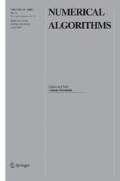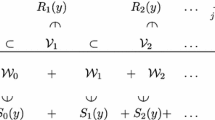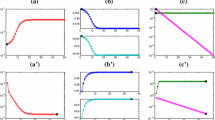Abstract
The package REGULARIZATION TOOLS consists of 54 Matlab routines for analysis and solution of discrete ill-posed problems, i.e., systems of linear equations whose coefficient matrix has the properties that its condition number is very large, and its singular values decay gradually to zero. Such problems typically arise in connection with discretization of Fredholm integral equations of the first kind, and similar ill-posed problems. Some form of regularization is always required in order to compute a stabilized solution to discrete ill-posed problems. The purpose of REGULARIZATION TOOLS is to provide the user with easy-to-use routines, based on numerical robust and efficient algorithms, for doing experiments with regularization of discrete ill-posed problems. By means of this package, the user can experiment with different regularization strategies, compare them, and draw conclusions from these experiments that would otherwise require a major programming effert. For discrete ill-posed problems, which are indeed difficult to treat numerically, such an approach is certainly superior to a single black-box routine. This paper describes the underlying theory gives an overview of the package; a complete manual is also available.
Similar content being viewed by others
References
R.C. Allen, Jr., W.R. Boland, V. Faber and G.M. Wing, Singular values and condition numbers of Galerkin matrices arising from linear integral equations of the first kind, J. Math. Anal. Appl. 109 (1985) 564–590.
R.S. Anderssen and P.M. Prenter, A formal comparison of methods proposed for the numerical solution of first kind integral equations, J. Austral. Math. Soc. (Series B) 22 (1981) 488–500.
C.T.H. Baker, Expansion methods, chapter 7 in [18].
C.T.H. Baker,The Numerical Treatment of Integral Equations (Clarendon Press, Oxford, 1977).
C.T.H. Baker and M.J. Miller (eds.),Treatment of Integral Equations by Numerical Methods (Academic Press, New York, 1982).
D.M. Bates, M.J. Lindstrom, G. Wahba and B.S. Yandell, GCVPACK — routines for generalized cross validation, Commun. Statist.-Simul. 16 (1987) 263–297.
M. Bertero, C. De Mol and E.R. Pike, Linear inverse problems with discrete data: II. Stability and regularization, Inverse Problems 4 (1988) 573–594.
Å. Björck, A bidiagonalization algorithm for solving large and sparse ill-posed systems of linear equations, BIT 28 (1988) 659–670.
Å. Björck, Least squares methods, in:Handbook of Numerical Analysis, Vol. 1, eds. P.G. Ciarlet and J.L. Lions (Elsevier, Amsterdam, 1990).
Å. Björck and L. Eldén, Methods in numerical algebra for ill-posed problems, Report LiTH-MAT-R33-1979, Dept. of Mathematics, Linköping University (1979).
H. Brakhage, On ill-possed problems and the method of conjugate gradients, in:Inverse and Ill-Posed Problems, eds. H.W. Engl and C.W. Groetsch (Academic Press, Boston, 1987).
T.F. Chan and P.C. Hansen, Some applications of the rank revealing QR factorization, SIAM J. Sci. Stat. Comp. 13 (1992) 727–741.
J.A. Cochran,The Analysis of Linear Integral Equations (McGraw-Hill, New York, 1972).
D. Colton and R. Kress,Integral Equation Methods for Scattering Theory (Wiley, New York, 1983).
L.J.D. Craig and J.C. Brown,Inverse Problems in Astronomy (Adam Hilger, Bristol, 1986).
J.J.M. Cuppen, A numerical soluiton of the inverse problem of electrocardiology, Ph.D. Thesis, Dept. of Mathematics, Univ. of Amsterdam (1983).
L.M. Delves and J.L. Mohamed,Computational Methods for Integral Equations (Cambridge University Press, Cambridge, 1985).
L.M. Delves and J. Walsh (eds.),Numerical Soluution of Integral Equations (Clarendon Press, Oxford, 1974).
J.B. Drake, ARIES: a computer program for the solution of first kind integral equations with noisy data, Report K/CSD/TM43, Dept. of Computer Science, Oak Ridge National Laboratory (October 1983).
M.P. Ekstrom and R.L. Rhodes, On the application of eigenvector expansions to numerical deconvolution, J. Comp. Phys. 14 (1974) 319–340.
L. Eldén, A program for interactive regularization, Report LiTH-MAT-R-79-25, Dept. of Mathematics, Linköping University, Sweded (1979).
L. Eldén, Algorithms for regularization of ill-conditioned least-squares problems, BIT 17 (1977) 134–145.
L. Eldén, A weighted pseudoinverse, generalized singular values, and constrained least squares problems, BIT 22 (1982) 487–501.
L. Eldén, A note on the computation of the genralized cross-validation function for illconditioned least squares problems, BIT 24 (1984) 467–472.
H.W. Engl and J. Gfrerer, A posteriori parameter choice for general regularization methods for solving linear ill-posed problems, Appl. Numer. Math. 4 (1988) 395–417.
R.D. Fierro and J.R. Bunch, Collinearity and total least squares, Report, Dept. of Mathematics, Univ. of California, San Diego (1991), to appear in SIAM J. Matrix Anal. Appl.
R.D. Fierro, P.C. Hansen and D.P. O'Leary, Regularization and total least squares, manuscript in preparation for SIAM J. Sci. Comp.
R. Fletcher,Practical Optimization Methods. vol. 1, 2nd ed. (Wiley, Chichester, 1987).
G.H. Golub and C.F. Van Loan,Matrix Computations, 2nd ed. (Johns Hopkins, Baltimore, 1989).
G.H. Golub and U. von Matt, Quadratically constrained least squares and quadratic problems, Numer. Mathematik 59 (1991) 561–580.
C.W. Groetsch,The Theory of Tikhonov Regularization for Fredholm Equations of the First Kind (Pitman, Boston, 1984).
C.W. Groetsch,Inverse Problems in the Mathematical Sciences (Vieweg Verlag, Wiesbaden), to be published.
C.W. Groetsch and C.R. Vogel, Asymptotic theory of filtering for linear operator equations with discrete noisy data, Math. Comp. 49 (1987) 499–506.
J. Hadamard,Lectures on Cauchy's Problem in Linear Differential Equations (Yale University Press, New Haven, 1923).
M. Hanke, Regularization with differential operators. An interative approach, J. Numer. Funct. Anal. Optim. 13 (1992) 523–540.
M. Hanke, Iterative solution of undertermined linear systems by transformation to standard form, submitted to J. Num. Lin. Alg. Appl.
M. Hanke and P.C. Hansen, Regularization methods for large-scale problems, Report UNIC-92-04, UNI.C (August 1992), to appear in Surveys Math. Ind.
P.C. Hansen, The truncated SVD as a method for regularization, BIT 27 (1987) 543–553.
P.C. Hansen, Computation of the singular value expansion, Computing 40 (1988) 185–199.
P.C. Hansen, Perturbation bounds for discrete Tikhonov regularization, Inverse Problems 5 (1989) L41-L44.
P.C. Hansen, Regularization, GSVD and truncated GSVD, BIT 29 (1989) 491–504.
P.C. Hansen, Truncated SVD solutions to discrete ill-posed problems with ill-determined numerical rank, SIAM J. Sci. Statist. Comp. 11 (1990) 503–518.
P.C. Hansen, Relations between SVD and GSVD of discrete regularization problems in standard and general form, Lin. Alg. Appl. 141 (1990) 165–176.
P.C. Hansen, The discrete Picard condition for discrete ill-posed problems, BIT 30 (1990) 658–672.
P.C. Hansen, Analysis of discrete ill-posed problems by means of the L-curve, SIAM Rev. 34 (1992) 561–580.
P.C. Hansen, Numerical tools for analysis and solution of Fredhold integral equations of the first kind, Inverse Problems 8 (1992) 849–872.
P.C. Hansen, Regularization Tools, a Matlab package for analysis and solution of discrete ill-posed problems; Version 2.0 for Matlab 4.0, Report UNIC-92-03 (March 1993). Available in PostScript form by e-mail via netlib (netlib@research.att.com) from the library NUMERALGO.
P.C. Hansen and D.P. O'Leary, The use of the L-curve in the regularization of discrete ill-posed problems, Report CS-TR-2781, Dept. of Computer Science, Univ. of Maryland (1991), to appear in SIAM J. Sci. Comp.
P.C. Hansen, D.P. O'Leary and G.W. Stewart, Regularizing properties of conjugate gradient iterations, work in progress.
P.C. Hansen, T. Sekii and H. Shibahashi, The modified truncate SVD method for regularization is general form, SIAM J. Sci. Statist. Comp. 13 (1992) 1142–1150.
B. Hofmann,Regularization for Applied Inverse and Ill-Posed Problems (Teubner, Leipzig, 1986).
T. Kitagawa, A deterministic approach to optimal regularization — the finite dimensional case, Japan J. Appl. Math. 4 (1987) 371–391.
R. Kress,Linear Integral Equations (Springer, Berlin, 1989).
C.L. Lawson and R.J. Hanson,Solving Least Squares Problems (Prentice-Hall, Englewood Cliffs, 1974).
P. Linz, Uncertainty in the solution of linear operator equations, BIT 24 (1984) 92–101.
Matlab Reference Guide (The Math Works, MA, 1992).
K. Miller, Least squares methods for ill-posed problems with a prescribed bound, SIAM J. Math. Anal. 1 (1970) 52–74.
V.A. Morozov,Methods for Solving Incorrectly Posed Problems (Springer, New York, 1984).
F. Natterer,The Mathematics of Computerized Tomography (Wiley, New York, 1986).
F. Natterer, Numerical treatment of ill-posed problems, in —.
D.P. O'Leary and J.A. Simmons, A bidiagonalization-regularization procedure for large scale discretizations of ill-posed problems, SIAM J. Sci. Stat. Comp. 2 (1981) 474–489.
C.C. Paige and M.A. Saunders, LSQR: an algorithm for sparse linear equations and sparse least squares, ACM Trans. Math. Software 8 (1982) 43–71.
R.L. Parker, Understanding inverse theory, Ann. Rev. Earth Planet Sci. 5 (1977), 35–64.
D.L. Phillips, A technique for the numerical solution of certain integral equations of the first kind, J. ACM 9 (1962) 84–97.
F. Santosa, Y.-H. Pao, W.W. Symes and C. Holland (eds.),Inverse Problems of Acoustic and Elastic Waves (SIAM, Philadelphia, 1984).
C. Ray Smith and W.T. Grandy, Jr. (eds.),Maximum-Entropy and Bayesian Methods in Inverse Problems (Reidel, Boston, 1985).
G. Talenti,Inverse Problems, Lecture Notes in Mathematics, 1225 (Springer, Berlin, 1986).
H.J.J. te Tiele, A program for solving first kind Fredholm integral equations by means of regularization, Comp. Phys. Comm. 36 (1985) 423–432.
A.N. Tikhonov, Solution of incorrectly formulated problems and the regularization method, Dokl. Adak. Nauk. SSSR 151 (1963) 501–504 [Soviet Math. Dokl. 4 (1963) 1035–1038].
A.N. Tikhonov and V.Y. Arsenin,Solutions of Ill-Posed Problems (Winston, Washington, DC, 1977).
A.N. Tikhonov and A.V. Goncharsky,Ill-Posed Problems in the Natural Sciences (MIR, Moscow, 1987).
A. van der Sluis, The convergence behavior of conjugate gradients and Ritz values in various circumstances, in:Iterative Methods in Linear Algebra, eds. R. Bauwens and P. de Groen (North-Holland, Amsterdam, 1992).
A. van der Sluis and H.A. van der Vorst, SIRT- and CG-type methods for iterative solution of sparse linear least-squares problems, Lin. Alg. Appl. 130 (1990) 257–302.
J.M. Varah, On the numerical solution of ill-conditioned linear systems with applications to illposed problems, SIAM J. Numer. Anal. 10 (1973) 257–267.
J.M. Varah, A practical examination of some numerical methods for linear discrete ill-posed problems, SIAM Rev. 21 (1979) 100–111.
J.M. Varah, Pitfalls in the numerical solution of linear ill-possed problems, SIAM J. Sci. Statist. Comp. 4 (1983) 164–176.
C.R. Vogel, Optimal choice of a truncationlevel for the standard SVD solutio of linear first kind integral equations when data are noisy, SIAM J. Numer. Anal. 23 (1986) 109–117.
C.R. Vogel, Solving ill-conditioned linear systems using the conjugate gradient method, Report, Dept. of Mathematical Sciences, Montana State University (1987).
G. Wahba,Spline Models for Observational Data, CBMS-NSF Regional Conference Series in Applied Mathematics, Vol. 59 (SIAM, Philidelphia, 1990).
G.M. Wing, Condition numbers of matrices arising from the numerical solution of linear integral equations of the first kind, J. Integral Equations 9 (Suppl.) (1985) 191–204.
G.M. Wing and J.D. Zahrt,A Primer on Integral Equations of the First Kind (SIAM, Philidelphia, 1991).
H. Zha and P.C. Hansen, Regularization and the general Gauss-Markov linear model, Math. Comp. 55 (1990) 613–624.
Author information
Authors and Affiliations
Additional information
Communicated by C. Brezinski and M. Redivo Zaglia
This work was supported by grants from Augustinus Fonden, Knud Højgaards Fond, and Civ. Ing. Frants Allings Legat.
Rights and permissions
About this article
Cite this article
Hansen, P.C. REGULARIZATION TOOLS: A Matlab package for analysis and solution of discrete ill-posed problems. Numer Algor 6, 1–35 (1994). https://doi.org/10.1007/BF02149761
Received:
Revised:
Issue Date:
DOI: https://doi.org/10.1007/BF02149761




